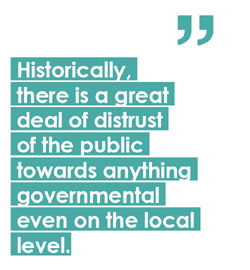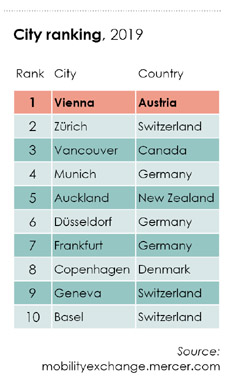What are the key components necessary for a quality life in the city?
Although at the Metropolitan Institute of Bratislava we work basically with architecture, urban design and planning, when we talk about quality of life we have to look at this question not only from the physical perspective, but also the economic. Affordability is the key. From the latest ratings of quality of life we know that Bratislava ranks around the 80th spot, while Vienna continues to occupy the very top spot for many years. Affordable housing becomes the key question for the city and its economic and social vitality. Second is the quality of mobility systems, the third, and this one will become crucial in the future, is climate wellbeing of the city.
 Which of these are present in Bratislava? Where do you see Bratislava’s biggest potential?
Which of these are present in Bratislava? Where do you see Bratislava’s biggest potential?
We have solid resources in terms of natural location and sources – Bratislava lies in the Carpathian Mountains, it is one of a few cities with both vineyards and forests within a 30-minute ride by public transport from the city center. And of course we have the Danube River acting as a huge cooling vessel. Additional lakes located within the tissue of the city are gems.
Bratislava is scoring very low on affordability of housing. As the capital it is the natural epicenter of population (not only from the region, but the whole of Slovakia, respectively Eastern Europe). At the same time, Bratislava is currently the third most expensive city in EU in terms of housing costs (compared to incomes). A third of Bratislava’s population is in danger of poverty, so you can see this is a very precarious situation. There are too few flats available, literally absent city rental housing, while demand is huge. That leaves us in a position when people from Bratislava can’t afford to live in the city and tend to commute from suburbs and even other regional centers. With the lack of vast, connected, and efficient railway systems connecting the capital and the regions this results in commuting in individual vehicles. We are talking about more than 100,000 people commuting on a daily basis who don’t use trains.

What are the cities that can serve as an inspiration for the future development of Bratislava?
Vienna in terms of its ideology of protecting public resources including housing, public space, green areas, mobility. Vienna owes its quality of life to the continuity of socially democratic and green politics – which demonstrates the close connection between urban planning and political views. Ljubljana serves as inspiration in terms of the size and speed of change. In three election terms the city changed from a car driven city to the European capital with one of the largest pedestrian zones. Ljubljana won the title of European Green city I believe in 2016. The shift to a healthy, high quality city (thanks to political stability and a draconian effort of its chief architect Janez Kozelj) is truly inspiring and shows that even post-communist cities in the Slavic region can catch up to the rest of Europe. I believe we are heading this way too.

How is Bratislava prepared to face the challenges brought on by the climate change in the next decades?
Our new strategic plan is addressing those issues in terms of establishing goals of sustainable development growth indicators. That means that every public project will be evaluated according to global metrics of indicators prepared for this challenge. In Bratislava we are coping with a huge deficit of data driven policies, evaluation and measuring the impacts – a data-focused approach and culture were literally non-existent. So this is a huge, methodical shift towards more conscious planning and management of resources.
Of course, even local politicians have realized that climate change is real, so planting trees became somewhat of a race. We are working on the reconstruction of many public spaces and providing public infrastructure. However, it is not only a matter of trees. We have to dig underground, relocate the underground infrastructure (so we can actually plant trees), we have to solve mobility – and provide more tram connections to all municipal districts – and this is a huge goal. For the first time in the history of Bratislava the parking policy will take effect. We have to provide alternatives in mobility so people can leave their cars at home and bike, walk or use public transport. That is just for the beginning. Protection of vulnerable groups that live in lower quality districts will also be a goal for the future.
What are your main goals at the Metropolitan Institute of Bratislava?
The institute serves as a think-do tank to set up systems and concepts related to the architecture and urban planning of the city. It aims to systematically push such planning that galvanizes public resources, planning that has social intelligence and is environmentally friendly. The team at the institute is rather young, highly educated. My colleagues generally have international experience and a huge drive for public service. I hope this is visible in our work. In terms of projects we work on the new master plan, strategic plan, we establish participatory planning, hold competitions and set criteria for projects (public spaces, rental housing).
Have you noticed a rising interest in the use and design of public spaces in the recent years?
Definitely. I would say Bratislava is going through a renaissance period – people rediscovering their city. The climate and pandemic crises are huge catalysts. People often spend more time outdoors and require higher quality neighborhoods. Personally I can feel it in the amount of emails and petitions that reach my office. People want a better city, they care and that is why we exist.
 It seems like many inhabitants of the city still feel that they simply don’t have the possibility to influence these decisions, so they choose to stay passive and criticize whatever is done. How can this approach be changed?
It seems like many inhabitants of the city still feel that they simply don’t have the possibility to influence these decisions, so they choose to stay passive and criticize whatever is done. How can this approach be changed?
It will be a long journey – but do not worry, we planners are mental marathon runners. I don’t take momentary disagreement as a reason to leave or change the project. Instead I am looking for the deeper roots of the problem. Historically, there is a great deal of distrust of the public towards anything governmental even on the local level.
At the same time the people do care – so often they use the well-known form of letting their voice be heard – petition or loud debates over Facebook that local politicians often regard as the true voice of the public. But we have proof it is not like that. Representation matters. The office of participatory planning was established to set the culture and system of dialogue with diverse groups of public so that projects can achieve higher quality.
Of course not every project can be participatory but the important ones are. Here we opt for different methods to show the people how to send us feedback that can be constructive and not violent. We do surveys, stakeholder meetings, workshops, walks, bicycle rides, we record and make our important discussions available online and interactive. We try various media formats, contribute to podcasts, right now we are working on an interactive exhibition.
And during the pandemic we learned how to utilize digital traces of the public online – that serves us as a great analytical support for decisions. Very soon we will be launching the manual of participatory processes for Bratislava – we believe it will set a clear and systemic structure in our city.
What are your favorite parts of Bratislava?
Danube. I walk along it almost daily.
Milota Sidorová, Director of Urban Studies and Participatory Planning Department, Metropolitan Institute of Bratislava



Follow us